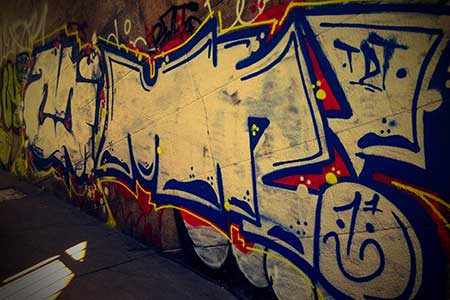
Graffiti-based vandalism continues to tattoo the urban landscape, defacing buildings, bridges, sidewalks, signs and other structures. The annual cleanup costs throughout the United States have been estimated between $8 billion to 12 billion.
In major cities such as New York, Las Vegas, Los Angeles and Chicago, the associated expenses for graffiti vandalism reach well into the millions each year.
Thus, local governments see graffiti gobble a bigger chunk of their strained budgets. Private building owners often end up responsible for expensive graffiti removal, and property values tend to go down while this type of crime keeps going up.
“From coast to coast, big cities and small, graffiti is an exorbitant cost to governments and taxpayers,” says Timothy Kephart, founder of Graffiti Tracker (www.graffititracker.com), a web-based system designed to help identify and prosecute graffiti vandals.
“It’s becoming a hugely significant issue for many city economies. There are so many aspects to how graffiti hits areas hard financially both in a typical week and long-term. So the urgency to address the problem has never been higher.”
Kephart breaks down four ways graffiti vandalism affects cities economically:
- Removal. Traditional methods to remove graffiti are expensive and time-consuming, involving repainting, pressure washing or harsh chemicals. The overall cleanup method – supplies, extra labor force needed, and time invested all are factored into the local government’s rising costs. “What compounds it is the cumulative effect; one graffiti incident attracts another,” Kephart says. “The cleanup efforts can never catch up.”
- Law enforcement. “Graffiti vandals are very hard to catch in the act,” Kephart says. “This is a crime that’s not typically reported to the police, so the true scope of the problem is unknown. Still, plenty is spent for investigating and prosecuting the graffiti that is reported. That takes time and resources.” One way cities are trying to get some of their cost back is to seek restitution from vandals.
- Property values. These are known to plummet in areas where graffiti is rampant. Driving away business is one of the effects. Some estimates say commercial real estate values can drop 25 to 30 percent if graffiti is within two blocks of a building. “People automatically associate graffiti with gangs and crime in general,” Kephart says. “The perspective of city officials is that graffiti leads to more graffiti, lowers property taxes, harms businesses and gives an overall negative perception of an area.”
- Non-government owners. While local governments get hit with the brunt of expenses for graffiti on public structures, private business owners often foot the bill for removing graffiti on their buildings. In some cities, property owners are required by law to remove illegal markings; failure to do so often results in fines. “These requirements leave many commercial property owners feeling doubly victimized – the second time at the hands of the city government,” Kephart says.
“A lot of these graffiti vandals get immediate gratification,” says Kephart, “while the areas and people affected get constant aggravation. They see it constantly and pay for it in some way.”
Timothy Kephart is the founder of Graffiti Tracker (www.graffititracker.com), a web-based system designed to help people identify, track and prosecute graffiti vandals. He holds a master’s degree in Criminal Justice from Cal State Long Beach.
Source: graffititracker.com
